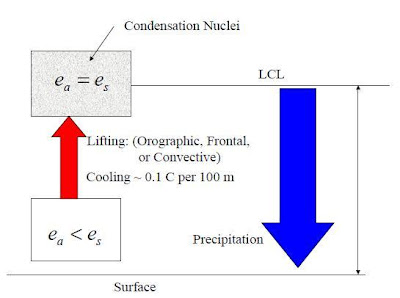The “mechanism” by which air is lifted is nominally used to classify the type of precipitation.
In general, there are 3 types of lifting mechanisms:
• Orographic lifting: In which air is forced to go over mountains (and it’s the reason why
windward slopes receive more precipitation).
• Frontal surface lifting: In which warmer air is forced to go above cooler air in equilibrium
with a cooler surface.
• Convective Lifting: Warm air rises from a warm surface and progressively cools down.
In general, there are 3 types of lifting mechanisms:
• Orographic lifting: In which air is forced to go over mountains (and it’s the reason why
windward slopes receive more precipitation).
• Frontal surface lifting: In which warmer air is forced to go above cooler air in equilibrium
with a cooler surface.
• Convective Lifting: Warm air rises from a warm surface and progressively cools down.
All
three mechanisms can lift air and hence result in the cooling process necessary
to reduce es and attain
RH=100%
As
earlier stated, condensation is a NECESSARY but NOT SUFFICIENT condition to the formation of precipitation.
Next, the remaining conditions necessary to the formation of precipitation as stated in figure below to summary of the key (idealized) processes leading to precipitation.
Condensation
Nuclei:
These
are particles in the atmosphere of the order of 0.1 to 10 μm.
These
particles originate from products of combustion, oxides of nitrogen, aerosols,
salt particles, etc…
Growth
of the water droplet:
The
saturated air tends to condense on these particles – and then water droplet
grow in size, become heavier, and fall to the ground as precipitation.










No comments:
Post a Comment